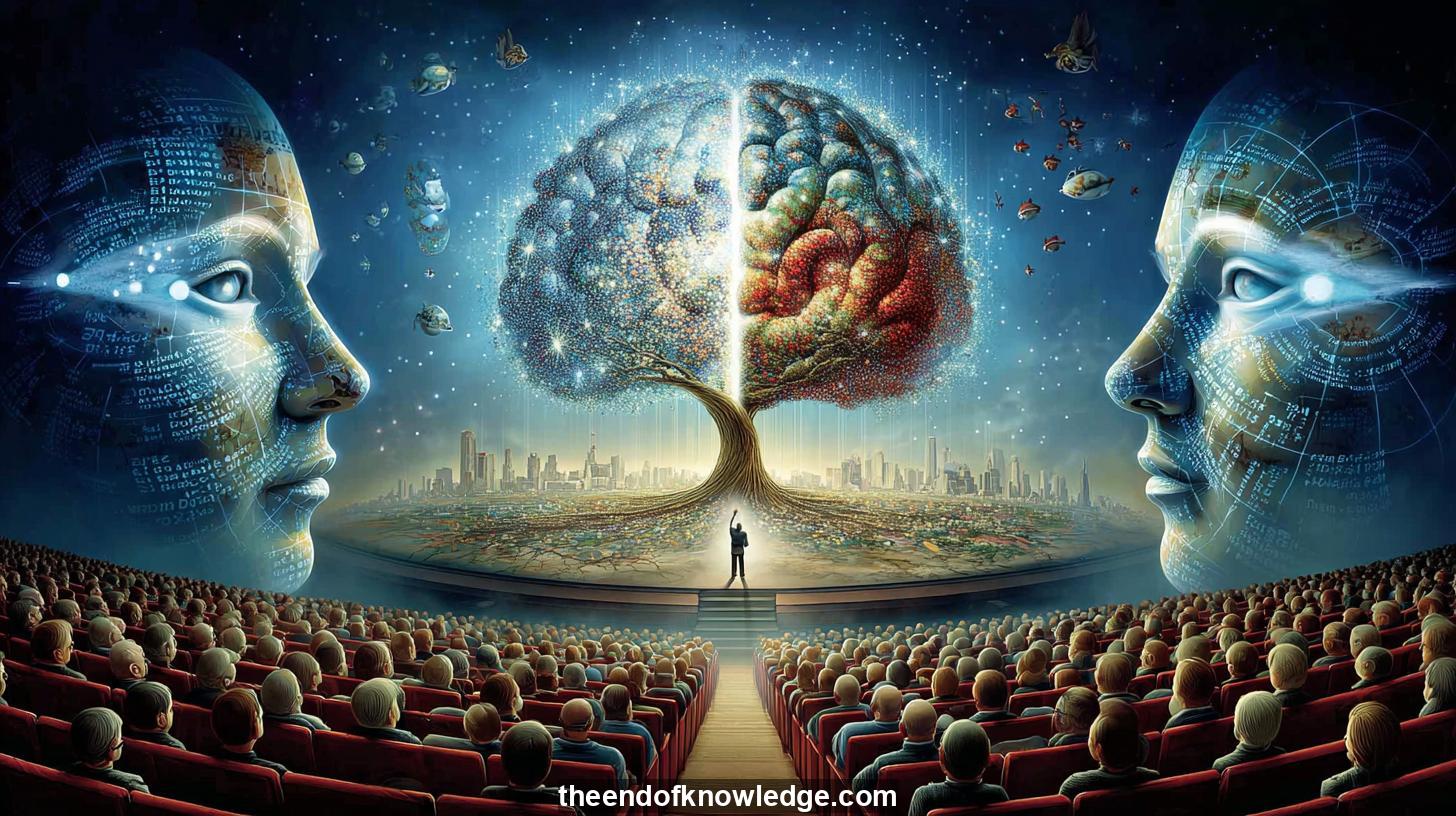graph LR
classDef data fill:#d1e7ff,font-weight:bold,font-size:14px
classDef cognition fill:#ffd1dc,font-weight:bold,font-size:14px
classDef critique fill:#fff4d1,font-weight:bold,font-size:14px
classDef future fill:#e0d1ff,font-weight:bold,font-size:14px
Main[Vault7-318]
Main --> DATA[Data & Models
Group]
DATA --> D1[1.8k objects,
4.7M triplets,
two models. 1]
DATA --> D2[66 semantic axes
emerge in models. 2]
DATA --> D3[Neural alignment with
human fMRI confirmed. 3]
DATA --> D4[Multimodal beats
language-only similarity. 4]
DATA --> D5[Behavioral paradigm
avoids proprietary access. 5]
Main --> COG[Cognition & Principles
Group]
COG --> C1[Universal principles
across modalities. 6]
COG --> C2[Multimodal closer
to human processing. 25]
COG --> C3[Spontaneous semantics
beyond training. 23]
COG --> C4[Older models reveal
alignment trends. 24]
Main --> PUB[Publication & Media
Group]
PUB --> P1[Machine Intelligence
June 9 Chinese team. 7]
PUB --> P2[Headlines oversimplify
cognitive convergence. 8]
PUB --> P3[Revive Xpaperay
for depth. 9]
Main --> DEB[Debate & Philosophy
Group]
DEB --> DEB1[Afternoon debate on
Apple AI limits. 10]
DEB --> DEB2[Krishnamurti radical
consciousness revolution. 11]
DEB --> DEB3[Peirce three-universe
ontology mapping. 12]
DEB --> DEB4[Reality zero: classical
physical sensors. 13]
DEB --> DEB4b[Reality X: symbolic
mind layer. 14]
DEB --> DEB4c[Reality Q: quantum
substrate. 15]
DEB --> DEB5[Reject utilitarian
AI dismissal. 16]
DEB --> DEB6[Behaviorist risks
in analysis. 17]
DEB --> DEB7[AI mirrors ego
crisis. 18]
Main --> COMM[Community & Future
Group]
COMM --> COMM1[Read paper,
avoid dogma. 19]
COMM --> COMM2[Alignment tools
close reasoning gap. 20]
COMM --> COMM3[Neuroscience benchmarking
via AI. 21]
COMM --> COMM4[Psychology-AI
research loop. 22]
COMM --> COMM5[Open Discord
crowd-funded. 26]
COMM --> COMM6[UBI, digital euro,
agentic futures. 27]
COMM --> COMM7[Humor amid
info deluge. 28]
COMM --> COMM8[Selective attention
in overload. 29]
COMM --> COMM9[Collective revolution
not theater. 30]
class DATA data
class COG cognition
class PUB critique
class DEB critique
class COMM future
Resume:
The speaker opens with a casual greeting and a technical note about Restream irregularities, then frames the session as a revival of the old "Xpaperay" format. He teases the afternoon debate on Apple’s reasoning and artificial intelligence, but first pivots to a freshly published paper whose headlines claim that Chinese researchers have shown large multimodal language models spontaneously develop human-like object concepts. He insists deserves careful reading beyond the sensational press, promising to unpack its methodology and implications.
He recounts how the study ran 4.7 million triplet judgments on 1,854 objects using GPT-3.5 and an early Gemini Vision model, revealing 66 low-dimensional semantic axes that align surprisingly well with human fMRI data. The behavioral paradigm, borrowed from cognitive psychology, lets researchers probe model representations without opening proprietary weights. The speaker stresses that even these dated models exhibit spontaneous semantic organization that mirrors human brain activity, hinting that newer systems may show still deeper convergence.
The discussion broadens into philosophy of mind: life, intelligence, consciousness, brain, mind, and the layered realities of zero (local), X (symbolic), and Q (quantum). Invoking Jiddu Krishnamurti and C. S. Peirce, he argues that humanity faces a crisis of consciousness in which AI acts as both mirror and catalyst. Rather than fear or dismiss this, we should embrace an intellectual revolution that questions inherited norms and utilitarian shortcuts.
He warns against dogmatism and reductionist takes that ignore the nuanced findings. The paper, he says, does not claim machines possess full human cognition but shows that one core cognitive process—object conceptualization—emerges naturally from scale and multimodality. This has immediate practical consequences: better alignment techniques, new benchmarks for evaluating future models, and bidirectional tools that let neuroscience and AI inform each other.
Closing with a call for open-minded curiosity, the speaker invites viewers to read themselves, join the Discord debates, and support the community financially if they can. He previews upcoming programs on universal basic income, digital currency, and agentic AI, insisting that only a collective intellectual awakening—not political theatrics—will guide society through the accelerating age of artificial intelligence.
30 Key Ideas:
1.- Researchers tested 1,854 objects across 4.7 million triplets using GPT-3.5 and Gemini Vision.
2.- Sixty-six low-dimensional semantic axes emerged spontaneously in both models.
3.- Neural alignment between model embeddings and human fMRI signals was statistically significant.
4.- Multimodal models showed stronger human similarity than language-only counterparts.
5.- Behavioral triplet paradigm bypasses need for proprietary architecture access.
6.- Results suggest universal organizational principles across data modalities.
7.- Study published in Machine Intelligence on June 9 by Chinese Institute Total team.
8.- Sensational headlines oversimplify nuanced cognitive convergence findings.
9.- Speaker revives Xpaperay format to dissect technical depth for community.
10.- Afternoon debate will tackle Apple reasoning and artificial intelligence limits.
11.- Jiddu Krishnamurti’s call for radical consciousness revolution frames discussion.
12.- C. S. Peirce’s three-universe ontology maps local, symbolic, quantum realities.
13.- Reality zero denotes classical physical experience accessible to brain sensors.
14.- Reality X mediates symbolic mind between quantum and classical layers.
15.- Reality Q embodies non-local quantum information substrate.
16.- Speaker warns against utilitarian dismissal of deeper AI cognition questions.
17.- Conductual analysis risks behaviorist reduction of consciousness debates.
18.- Crisis of human ego exposed by AI mirror demands intellectual awakening.
19.- Community urged to read paper, avoid dogmatic headlines, form own conclusions.
20.- Findings enable better alignment tools closing model-human reasoning gap.
21.- Cognitive neuroscience gains new benchmarking instruments via AI representations.
22.- Bidirectional research loop promised between psychology and artificial systems.
23.- Spontaneous semantic organization hints at emergent properties beyond training.
24.- Older models chosen for simplicity yet reveal profound alignment trends.
25.- Multimodal integration proves closer to human cognitive processing than text alone.
26.- Speaker advocates open Discord debates and crowd-funded sustainability.
27.- Upcoming programs will probe universal basic income, digital euro, agentic futures.
28.- Humor and self-critique punctuate dense technical exposition to maintain sanity.
29.- Infinite knowledge explosion challenges selective attention and mental health.
30.- Collective revolution, not political theater, required to navigate accelerating AI age.
Interviews by Plácido Doménech Espí & Guests - Knowledge Vault built byDavid Vivancos 2025
 >
>